"A nation that does not know its past does not understand its present, and cannot create its future!"
Europe needs Hungary... which has never let itself be defeated.
The Habsburg power again resorted to the weapon of violence
After Lipót's short reign, his eldest son, Ferenc, also from the House of Habsburg-Lorraine, who was already born in Florence, ascended the Hungarian throne. (It should be noted that in addition to taking the Hungarian and Czech crowns, he was the last emperor of the German-Roman Empire under the name Ferenc II, and from 1804, when the Austrian Empire was established, its first ruler.)
The year 1792 was not only the year of Francis' accession to the throne, but also the period of radicalization of the French Revolution. France's neighbors, Prussia and the Habsburg Empire - although in different ways - became familiar with the idea of the Enlightenment and partially accepted it. However, they were not willing to acknowledge the persecution of the church and the trampling of the imperial and royal power taken from God into the mud. This was already in 1791, even in II. Leopold and the Prussian II. Vilmos Frigyes' statement issued in Pillnitz made it clear. According to this, they would declare war on Paris if the French king (Louis XVI) were to suffer, or if ecclesiastical and secular dignitaries were persecuted. The contradictions intensified when the republic was proclaimed in France. The new, "democratic" French state attacked the Habsburg Empire in April 1792. In France, the monastic orders were dissolved in a short time, some of the priests were murdered, and many thousands of church members were persecuted, chased away, and deported.
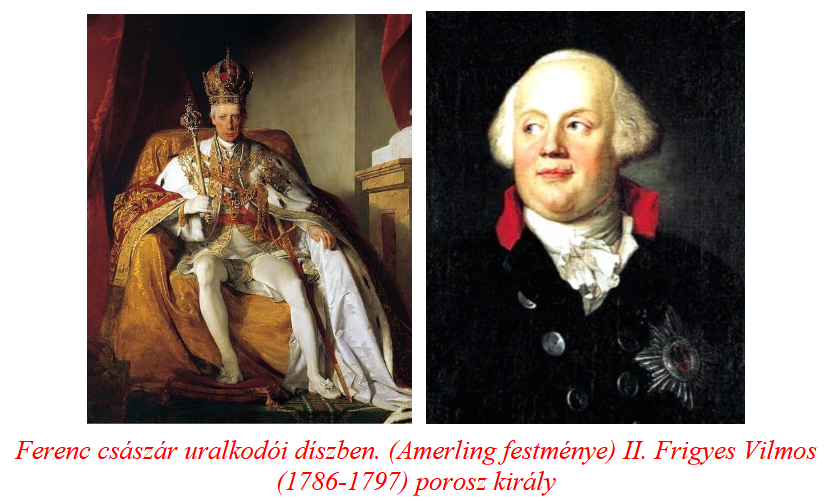
France is a hotbed of Christian persecution
In France, social contradictions had already developed before 1789, which the freemasons, the promoters of the so-called "Enlightenment", took full advantage of. The ideology coming from England set its flag on the ruthless destruction and persecution of the existing social order and Christianity. Already in 1782, the French, Scottish, German and other Western European lodges (secret, closed societies) held a congress, which decided on the construction of a new world order. Without touching the history of the first secret society founded in England in 1717 and the lodges that developed from it, let's stay with the activities of the French Freemasons. Without denying the real misery of the people, the poor agricultural harvest of the years before 1789, the irritating, wasteful lifestyle of the royal court, the famous day - July 14, 1789 - which the French still consider their greatest national holiday, was carefully prepared. The intellectual basis was created by the Great French Encyclopedia. The 35 volumes published between 1751 and 1780 served as a systematic dictionary of various sciences, arts, culture, and crafts. Its creators, the best-known figures of the Enlightenment and the revolution that developed from it were Voltaire, Diderot, Rousseau, d'Alambert, Helvetius, Montesquieu, Benjamin Franklin, Mirabeau and others. The bearers of these names, despite the fact that they destroyed a system and a world religion, are still considered among the greats of history, literature and science in the cultured West.
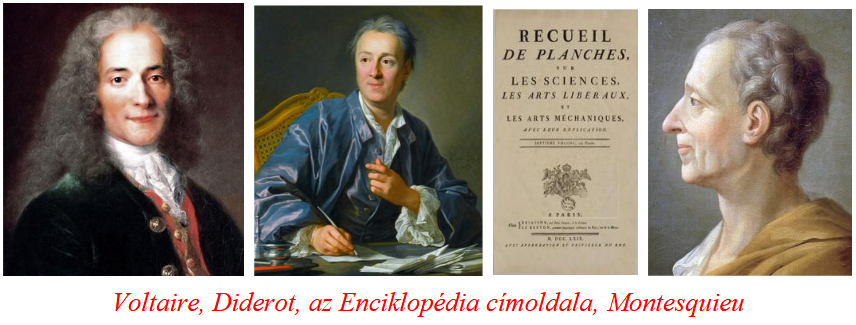
The Encyclopaedia was indeed a huge undertaking, but what it brought about led to huge historical and social changes throughout Europe and even in the areas inhabited by Indians in North America at the time. We know the names of the listed big-name authors and their followers, we know about the bright side of the Enlightenment, the revolution, the Napoleonic era, but even less about the dark side. Sharp debates also broke out among the leading minds. Voltaire, for example, called the citizen of Geneva a "malicious madman" - as Rousseau called himself - who, on the other hand, described Voltaire as "proclaimer of impiety, elevated in his spirit, but evil in his soul". According to Rousseau, followers of Jesus can never be good citizens unless they deny their faith. He goes further when he talks about the encroachment of the Christian religion. Considering that the facts of the following brief summary are less known in Hungarian public opinion, the Glorious Revolution is taught even more in some of our universities. That is why the horrors may seem unbelievable, but you can easily look them up based on the sources. (In the works of Gerő Pál Bozsóky, Konrád Szántó, Jenő Horváth, Ernő Raffay, László Zsolt Mézes, Antal Meszlényi and others.)
Perhaps the two things are not related, because they are far apart in time. However, let's not forget the period between the Captivity of Avignon (1309-1377), when the papacy moved its seat from Rome to the French city of Avignon. Without going into details, the first spectacular attack against Rome of the revolution of 1789 was when Bishop Talleyrand (1754-1838) bypassed the Pope and ordained two new French bishops himself. This was not new either, since in England as early as 1534 VIII. Henry broke with the Roman Catholic Church when he established the Anglican Church, declaring himself the head of the new church. This is still the case in Britain today. Even earlier, Márton Luther (1483-1546) turned against Rome when he announced the Reformation in 1517, thus creating the foundations of the Lutheran Church, which started the Christian-Christian antagonisms. Stepping back a century, the death at the stake of János Husz (1369?-1415) on July 6, 1415 became the beginning of the process that then led to Rome's never-ending battle with the new churches and belief systems that attacked it.
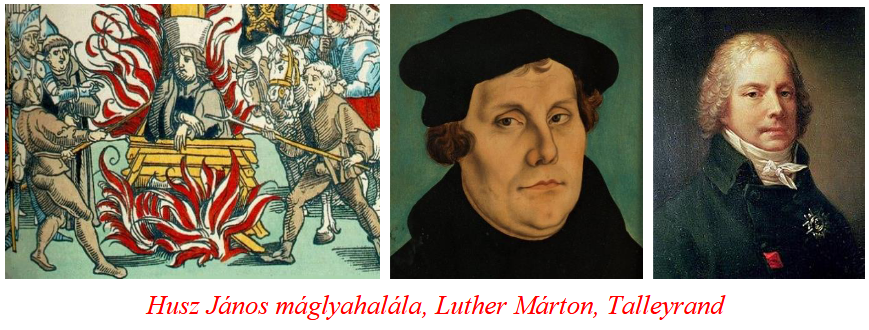 Returning to the events in France, 1,400 prisoners were executed already in 1791, including about 300 Catholic priests. They then expelled 30,000 church leaders from the country who refused to renounce Rome, who refused to take the oath of allegiance to the constitution of the "revolutionary state". Many of the French refugees found refuge in Hungary.
Returning to the events in France, 1,400 prisoners were executed already in 1791, including about 300 Catholic priests. They then expelled 30,000 church leaders from the country who refused to renounce Rome, who refused to take the oath of allegiance to the constitution of the "revolutionary state". Many of the French refugees found refuge in Hungary.
We can only highlight a few of the anti-Christian activities of the French "revolution", because it is impossible to go into details. Among other things, on November 7, 1793, Christianity and the church were abolished by law. They introduced the power of Reason and Nature as the new religion. A spectacular ceremony took place at Notre Dame Cathedral, where a topless actress celebrated as the Goddess of Reason was placed on the altar. Churches were transformed into stables, warehouses, pubs, and clubs. This is how the name of the radical Christian persecutors nesting in the church of St. James in Paris became the Jacobin party, and the name of the church became the Jacobin club. God was banned, replaced by Marat, the radical herald of the revolution, who had to be revered as a god.
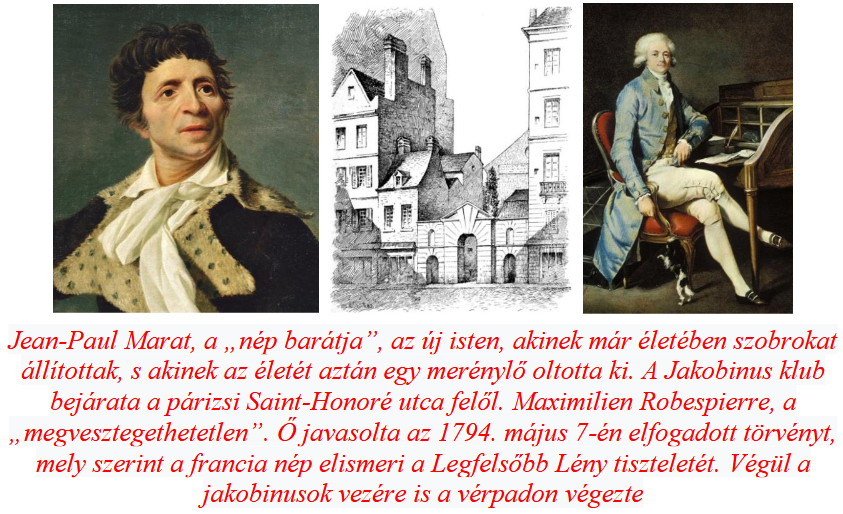
Let's not forget about the use of the so-called "white neck brace", which was popularly used in the execution of priests. The method consisted of herding the victims onto a transport ship, who were then sunk alive along with the ship. Thus, thousands of people were executed with this method as well. The "modern age" after 1789 continued with the massacre in the Vendée department. The population of the affluent region on the ocean coast initially supported the idea of the revolution. But when the news of excessive taxes, conscription, persecution of priests, and the execution of the king reached here, the vast majority of the population no longer supported Paris. In response to this, the parliament of the republic, the supreme promoter of human equality, passed a law in August 1793 to exterminate the people of Vendée. Saint-Just declared: "Those who cannot be ruled with justice must be ruled with iron." (How familiar this sentence is from the mouths of the leaders of the bloody communist revolutions of the 20th century.) The reality - according to contemporary descriptions - seems unbelievable to today's people, because the Parisian democrats have reached such a level of human horrors that it is the "Dark Ages" it would have been unimaginable even for a human. Especially with little girls and pregnant women, they committed selective tortures - which I will refrain from describing - because the reader's nerves would not bear it. (Refined, I note one or two cases to prevent speculation. For example, human skin was prepared by tanning and then used for clothing for the army, or when 150 women were burned alive at the stake and their fat was collected in barrels and sent to the cities for use. The women, little girls (I will leave the description of rapes against and the brutal execution of babies to another person.) All this is done by the dehumanized leadership of the French Republic with its own people after the Declaration of Human and Civil Rights was promulgated and enshrined in law. To this day, the names of the perpetrators and those who issued orders are still displayed on the street name signs of many French settlements.
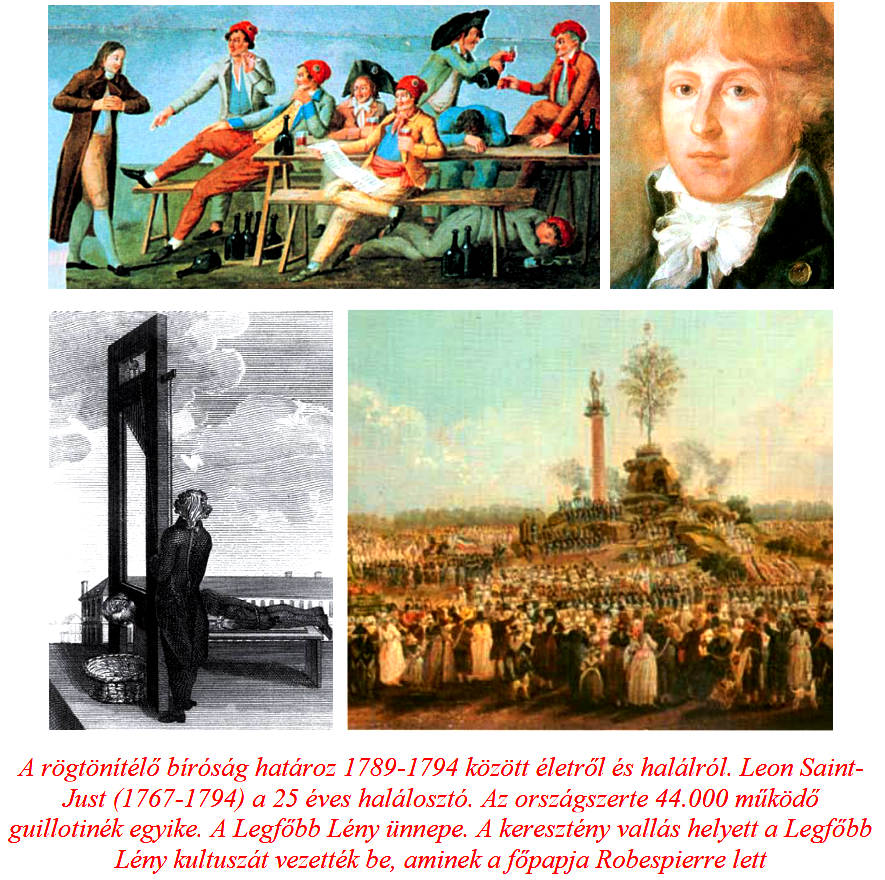
The situation did not change much when Napoleon took power. In 1801, Napoleon, the first consul, concluded a contract with the Pope. According to this, the church renounced its property in France, which had been taken since 1789, and acknowledged that the priests were paid by the state. Rome also had to put up with the fact that the remaining fifty bishops were appointed and paid by the first consul, i.e. the priests were from then on employed by the state.
The scene on December 2, 1804, when Paris was preparing for Napoleon's coronation as emperor, is well known. At the ceremony VII. Pope Pius also appeared with the hope that he would be able to place the imperial crown on Napoleon's head. At the decisive moment, however, Napoleon snatched the crown from the Pope's hand and placed it on his own head. The event had two important meanings. On the one hand, Napoleon wanted to win over millions of French Christians to his cause by having the Pope present at the ceremony. On the other hand, he informed those present that he was above the Pope and that the Vatican had no influence whatsoever on the French imperial court.
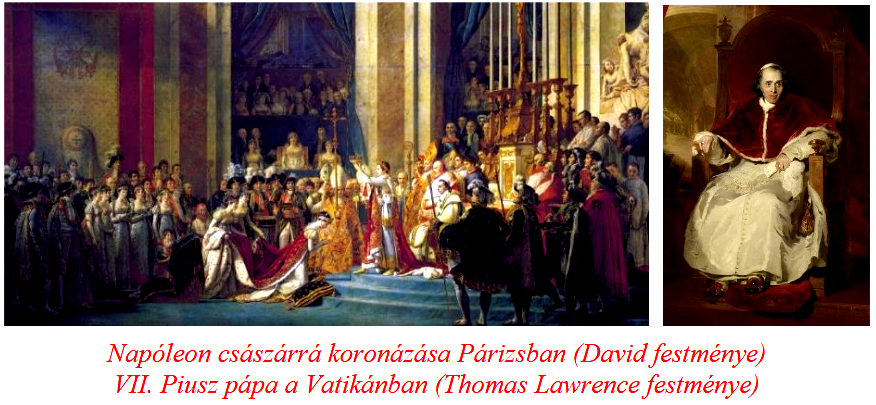
In 1808, Emperor Napoleon's army occupied Rome, including the Castel Sant'Angelo. With this conquest, the Papal States practically became part of France. VII. Pope Pius was captured by the French. (It should be mentioned that Hungarian hussars freed the pope from the captivity of Napoleon's soldiers and escorted him home to Rome.) Napoleon's plan to build the Vatican in Paris and keep the pope there was ultimately not realized.
(Note: In this series, it is not customary to look forward to the present day, although each of the discussed eras shows the logic of historical eras built upon each other, the laws of repetition. However, if we think about the events of the persecution of Christians at the end of the 18th and the beginning of the 19th century we must inevitably draw parallels with the situation today. The spirit of the French Revolution reached the "civilized world" again through the communist revolutions.)
The reign of Francis I of Habsburg
The II. Joseph, II. The changes in France during the years of the reign of Leopold and Francis I had a great impact not only on neighboring Austria, but also on the whole of Europe, and even the history of North America was shaped by the French Enlightenment. We cannot disregard the events in France outlined in the previous chapter, because Vienna's politics must be interpreted in this light. The rigid, absolutist Emperor Francis cannot be excused from his anti-national measures against the Hungarians! However, consider the disastrous, anti-human policies that Paris followed in the neighborhood of the Empire.
Emperor Francis was one of the biggest opponents of Napoleon Bonaparte, who set out to conquer Europe. He continued his father's policy against "enlightened" France. Franciscan absolutism, as his system was called, shows the image of a man struggling with many contradictions. In his youth, he was weak-willed, insecure, full of feelings of inferiority, but at the same time, he read a lot, was educated, loved literature and music, and was interested in the sciences. In the first years of his reign, in 1795, he abolished the movement of the Hungarian Jacobins, setting an example for his unyielding policy against the French Revolution. (This event is discussed in a separate chapter.)
In the Battle of Austerlitz (near Brno in the Czech Republic), which took place on December 2, 1805, the French won a brilliant victory over the outnumbered Austro-Russian allied army. Emperor Francis was a real politician. Seeing Napoleon's strength and genius, he returned to the proven Habsburg policy of "Just marry, happy Austria!" to practice. However, he could not accept the terror in France, which is why he developed a strong opposition to the Enlightenment. He introduced a strong police rule in his empire, and established a well-functioning spy and official network in his countries. Despite this, a series of failures befell the emperor. Among other things, in 1806 he was forced to renounce his title of German-Roman Emperor. He also expected the help of the Hungarians against the Napoleonic French army advancing towards the east. In 1809, the Hungarian nobility announced a noble uprising against Napoleon, but the Hungarian nobility, following outdated warfare, suffered a heavy defeat in the Battle of Győr. This battle entered our history as the "Running of Győr".
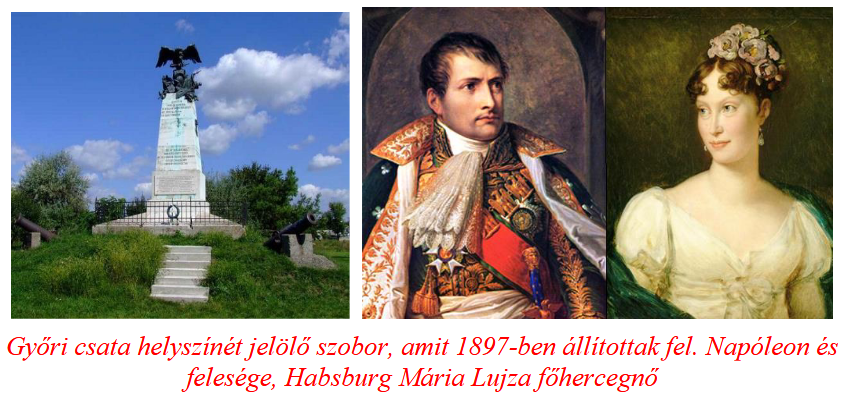
Emperor Francis gave his 19-year-old daughter, Archduchess Mária Lujza, to Napoleon in 1810 for the sake of peace. It is characteristic of his indecisiveness and influence that he changed political direction several times during the following years. The 22-year-old Klemens Metternich, who in 1795 became one of the leaders of Viennese politics, contributed to this to a large extent. When Metternich married the granddaughter of Maria Theresa's powerful chancellor, Count Kaunitz, he was able to develop his abilities.
At Metternich's suggestion, Emperor Francis I already made troops available to Napoleon marching against Russia in 1812. After the failure of the French in Russia, Austria supported the Russo-Prussian alliance in a major turn. It marked the crowning of Franz's policy when, in 1815, Vienna hosted the Russian Tsar Alexander I, III. of the meeting between King Frederick William of Prussia and Emperor Franz I. The three rulers created the Holy Alliance. It was not an easy inheritance for King Francis. After all, Mária Theresa's grand reign, II. József's rigid conservatism, II. After Lipót, the representative of the Enlightenment, Ferenc could not escape the influence of advisers and the increasingly alarming events in France. The given historical circumstances made Emperor Francis, who was organized to protect conservative, Christian values, a rigid, absolutist ruler.
The 1811-1812. At the Hungarian Parliament in 2010, Emperor Francis appeared in a hussar uniform and addressed the representatives in Hungarian, thus winning the sympathy of the Hungarian nobility. (He followed Mária Terézia's theatrical policy of 1741.) True, he did not convene a parliament after that. However, at the request of the counties, the national assembly had to be convened again in 1825, which is referred to in our history as the beginning of the reform national assemblies.
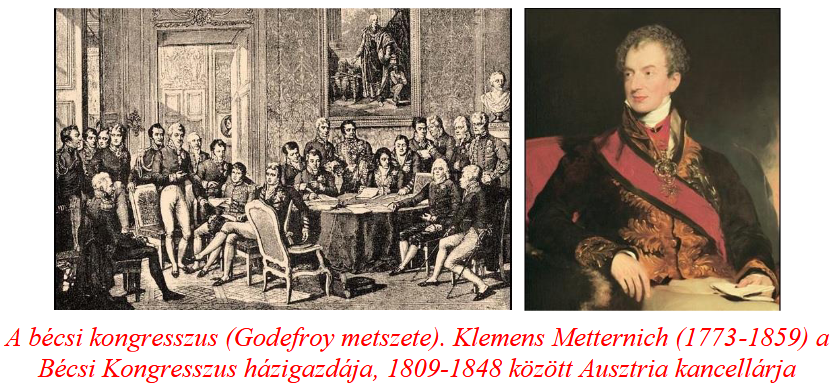
The policy of King Francis in Hungary
Already in the year of his accession to the throne, in 1792, a law was passed on the use of the Hungarian language: "On the teaching and use of the Hungarian language", for example, it stated the following:... With the approval of His Royal Highness, the faculties and orders decide that the teaching of the Hungarian language within the borders of this country from now on, it should be a normal subject, so that in this way, over a certain period of time, only those who, in addition to their other, properly completed studies, can prove their knowledge of the Hungarian language with a teacher's certificate, will win public office within the borders of the country."
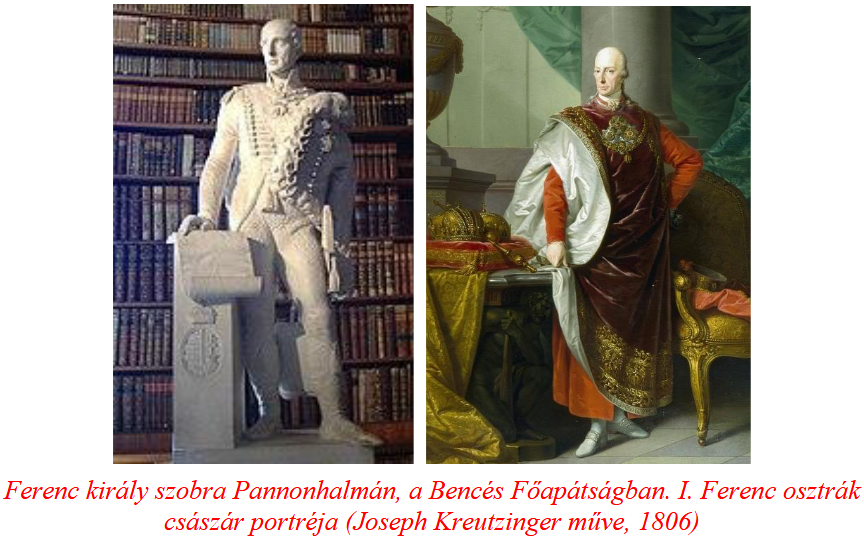
However, the spirit of reform in Hungary could no longer be suppressed. Vienna's policy was not only against the consequences of the French Enlightenment, but also trampled our national aspirations. Ferenc Kazinczy's six-year imprisonment in Kufstein indicates that Vienna punished the promoter of the Hungarian language and Hungarian national interests. The behavior of the Hungarian nobility and intelligentsia is well characterized by the fact that when Kazinczy was released from captivity in 1801, his modest estate in Zemplén became a national pilgrimage site, where the most distinguished politicians, writers, and poets visited to meet the language reformer, the leader of Hungarian literature and the shaping of social relations. .
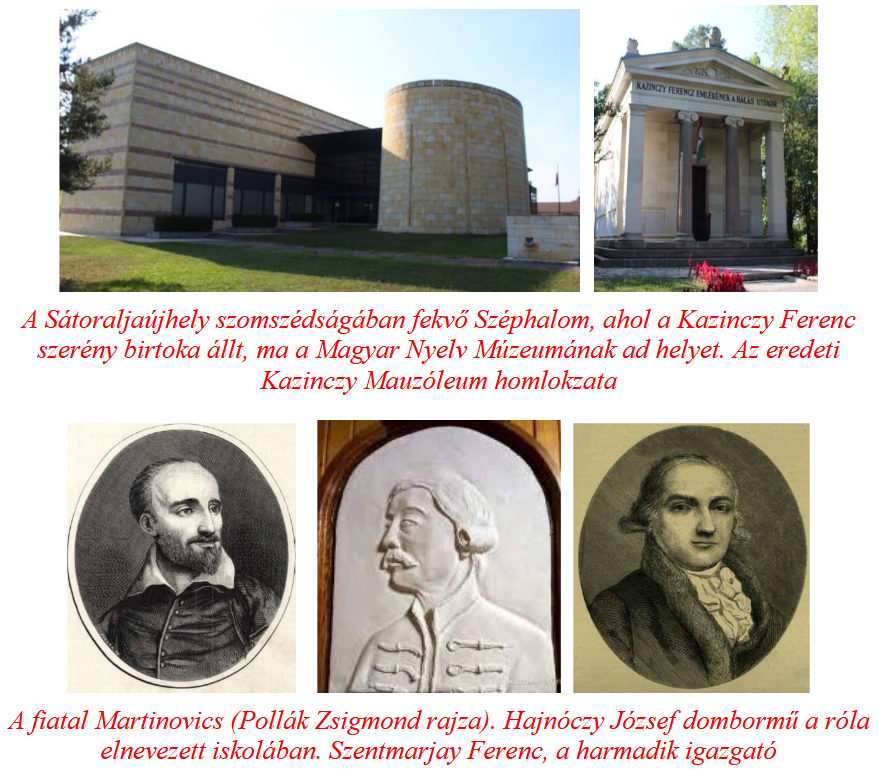
The Martinovics conspiracy
The Albanian grid installed in our country at the end of the 17th century? scion of the family, Ignác Martinovics (1755-1795) was a smart but restless young man. After graduating from the Piarist High School in Pest, he became a Franciscan monk, but was constantly in conflict with his peers and superiors. He completed, among other things, theology, and then, breaking with the monastic life, traveled almost all of Europe accompanied by the Polish lord Ignác Potocky. He became an excellent teacher, as evidenced by the fact that he was elected a member of a number of European academies. However, his application for the physics department of the University of Pest was unsuccessful, which caused him a break and a great disappointment.
For the sake of his career, Martinovics took several steps that have already earned him the court's displeasure. In 1791, still II. During the reign of Lipót, the Viennese secret police employed the talented young man. He had to write reports on the activities of the Jesuits, Freemasons, and Illuminati. He heavily colored his reports, which contained little usable data, to increase his own importance. Martinovics wanted more, more power, he wanted to make better use of his talent. After 1792, when Ferenc I came to the throne, he had his supporters as well as his open enemies. He was no longer trusted because of his anger and constant dissatisfaction, so he fell out of favor in Vienna. In desperation, he moved to Pest, where he began seditious activities. In his first – anonymous – pamphlet, he attacked censorship. In his second open letter, under the name of Count Gorani, he criticized the policy of the House of Habsburg, and the very kings who had previously patronized him helped his activities. Given that he was spreading the ideas of the French Revolution, the Freemasons (Illuminati) supported the instigator. They are precisely those on whom Martinovics previously wrote reports.
The organization in Hungary was introduced to Martinovicc by Ferenc Gyurkovics, a professor at the University of Pest, but he was unable to recruit him into the secret society. The first revolutionary catalog was also edited by Gyurkovics, it was not Martinovics' work either. Gyurkovics left his documents, correspondence and the design of the caté to Martinovics before his death shortly after.
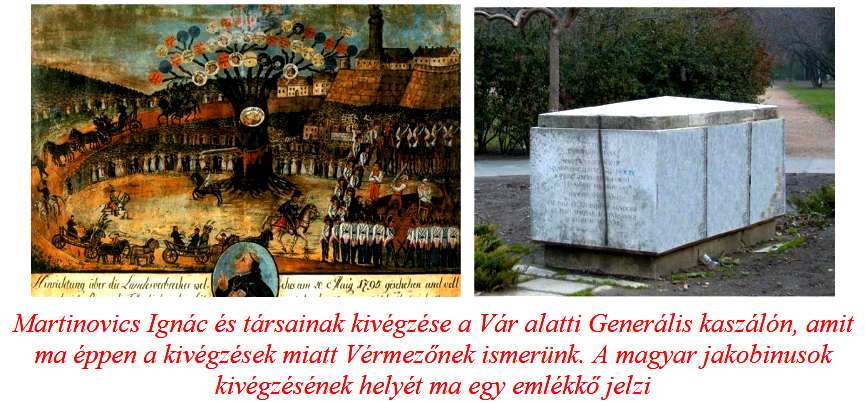
As soon as Martinovics became the leader of the organization, he immediately started recruiting members. The Parisian Jacobins entrusted him with the activity, which was a great honor for Martinovics. He organized two companies, but neither knew about the other. Only Martinovics knew the names of both companies. One was the Society of Reformers, the membership of which consisted of nobles and impoverished aristocrats. The members of the Freedom, Equality, Brotherhood Society came from the ranks of young radical intellectuals. Recruitment initially took place in Vienna. The organizers planned a membership of 250,000 people, which they believed would have enabled them to take over power. The number of members was only 75 when an incorporated person reported on the organization. Even after three months, the number of employees did not exceed 300. Before the fall, which Martinovics found out in time, he immediately hurried to Vienna, where he revealed the organization he had initiated himself. Martinovics provided the secret police with the names and programs of both secret societies. In addition, the adventurous politician left his fellow directors, József Hajnóczy, János Laczkovics, Ferenc Szentmarjay and Jakab Sigray, alone. However, he did not escape the punishment either. Based on the decision of the Royal Inquisition, the five directors were executed on May 20, 1795.
The execution by pallos took place in the meadow below the Buda Castle, which at the time was known as the General's Mow. Today, this area is called the Field of Blood precisely because of the execution of the leaders of the conspiracy led by Martinovics. According to the recollections of eyewitnesses, when Sigray Jakab was the first to be executed by the executioner, which he only managed to do three times, Martinovics fainted. He never recovered from this state. The young executioners dragged him to the blood bench, reaching under his arms from both sides.
The judges deliberated for another two weeks in the case of two unyielding Jacobin believers. Although Pál Őz and Sándor Szolartsik were not leaders, they persistently defended the events of the Paris terror, which is why they were also executed on June 3, 1795. The executed were buried in the military cemetery at the corner of Szilágyi Erzsébet fasor and Kútvölgyi út, which was only excavated in 1914.
Death of King Francis
After the historical events of 1795, another forty years passed, when Emperor Francis and the Hungarian king passed away. These four decades are an incomparably rich period of Hungarian history and literature, we can safely say, the age of geniuses. It is enough to mention Ferenc Széchenyi and István Széchenyi, Lajos Kossuth, Ferenc Deák, Lajos Batthyány, József Eötvös, Mihály Csokonai Vitéz, Sándor Petőfi, Mihály Fazekas, Mihály Vörösmarty, József Katona, Miklós Wesselényi, Imre Madách, Mór Jókai, János Arany. , Mihály Pollack, Ferenc Liszt, Ignác Semmelweis, Teréz Brunszvik, Blanka Teleki, Ányos Jedlik, Ferenc Erkel, Ferenc Kazinczy, Ferenc Kölcsey, Miklós Barabás, János Kriza. Here I tried to list only those great men - the list is certainly not complete - who created the greatest achievements in their own historical, artistic and scientific fields. What an age! What a star system it took for these geniuses to even know each other, meet, and work together. And behind them stood an army of Hungarian politicians, artists and scientists, also blessed with great talent, whose names would fill an entire book. And a few years before that, the German scientist Herder said that Hungarians and the Hungarian language would disappear from the map of Europe in two centuries. Whoever has even a drop of Hungarian blood in him, his mouth twitches into a smile at how wrong poor Herder was. Let's not judge him, he didn't do it with bad intentions, it's just that German science and Hungarian reality certainly didn't meet here. Not for the first time and not for the last time!
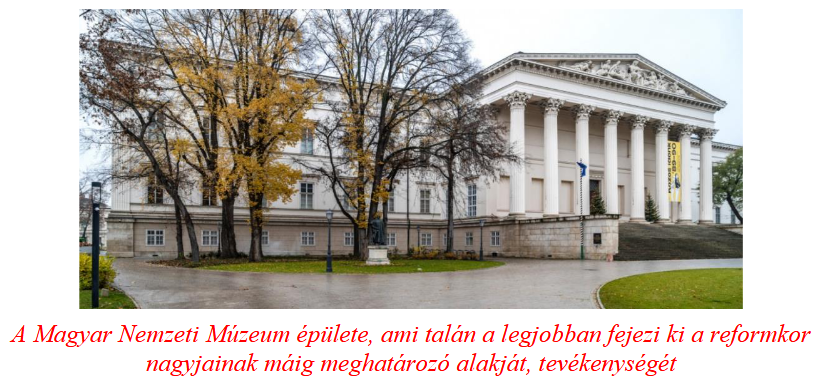
The era that covers the period of the controversial reign of Ferenc I began with the Hungarian Reformation. The list above and the inexhaustible richness of the topic require that we discuss this glorious period in the next chapter. We can reflect on the extent to which the French terror, the rigid, dictatorial Habsburg rule, and what has not yet been mentioned, the revitalization of the peoples of the Carpathian Basin contributed to these decades, which represent a bright era for us. An apt answer to this can be found in a proverb: The palm tree grows under weight!
Emperor Francis died on March 2, 1835 in Schönbrunn at the age of 67. He was married four times. Ferdinand, the eldest son, was born from the second marriage of Mária Theresia to Princess Carolina of Naples and Sicily in 1790, who would succeed Ferenc on the Habsburg throne. One can speculate that Ferdinand was really weak-minded, or that this epithet was only applied to him so that he could be removed from the imperial and royal seat during his lifetime - which is unprecedented in the Habsburg succession to the throne - to make room for Francis Joseph I. It is worth knowing that Mária Terézia Karolina was Ferenc's niece, which does not rule out blood relations and, as a result, abnormalities in the child born.

Author: Ferenc Bánhegyi
The parts of the series published so far can be read here: 1., 2., 3., 4., 5., 6., 7., 8., 9., 10., 11., 12., 13., 14., 15., 16., 17., 18., 19., 20., 21., 22., 23., 24,, 25., 26., 27., 28., 29/1.,29/2., 30., 31., 32., 33., 34., 35., 36., 37., 38., 39., 40., 41., 42., 43., 44., 45., 46., 47., 48., 49., 50., 51., 52., 53., 54., 55., 56.













